Heptophylla gongshana Bezděk & Král, n. sp. from China (Yunnan) and a Checklist of the Tribe Heptophyllini (Scarabaeidae: Melolonthinae) †
Abstract
1. Introduction
2. Materials and Methods
3. Results
3.1. Description of New Species
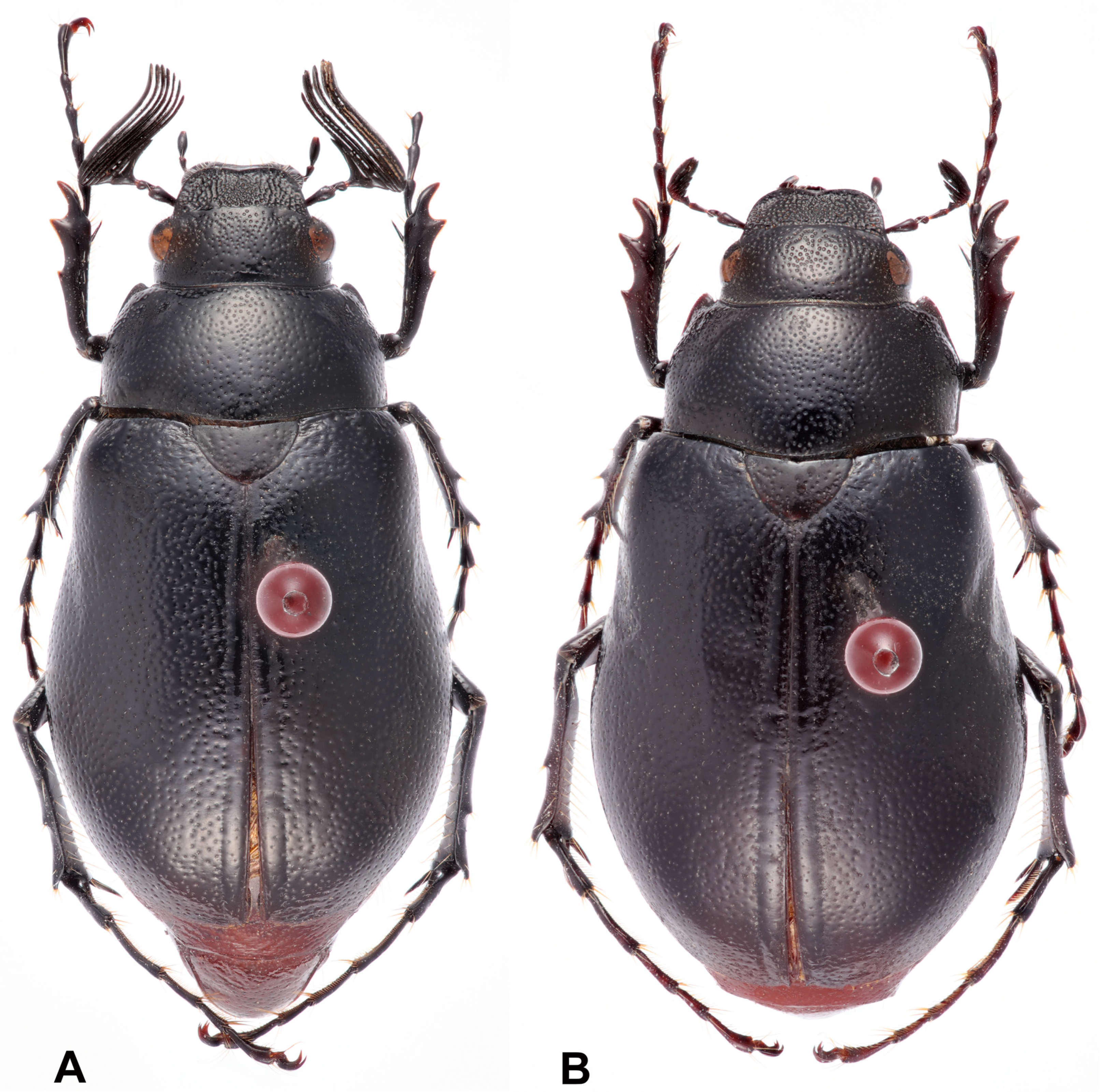
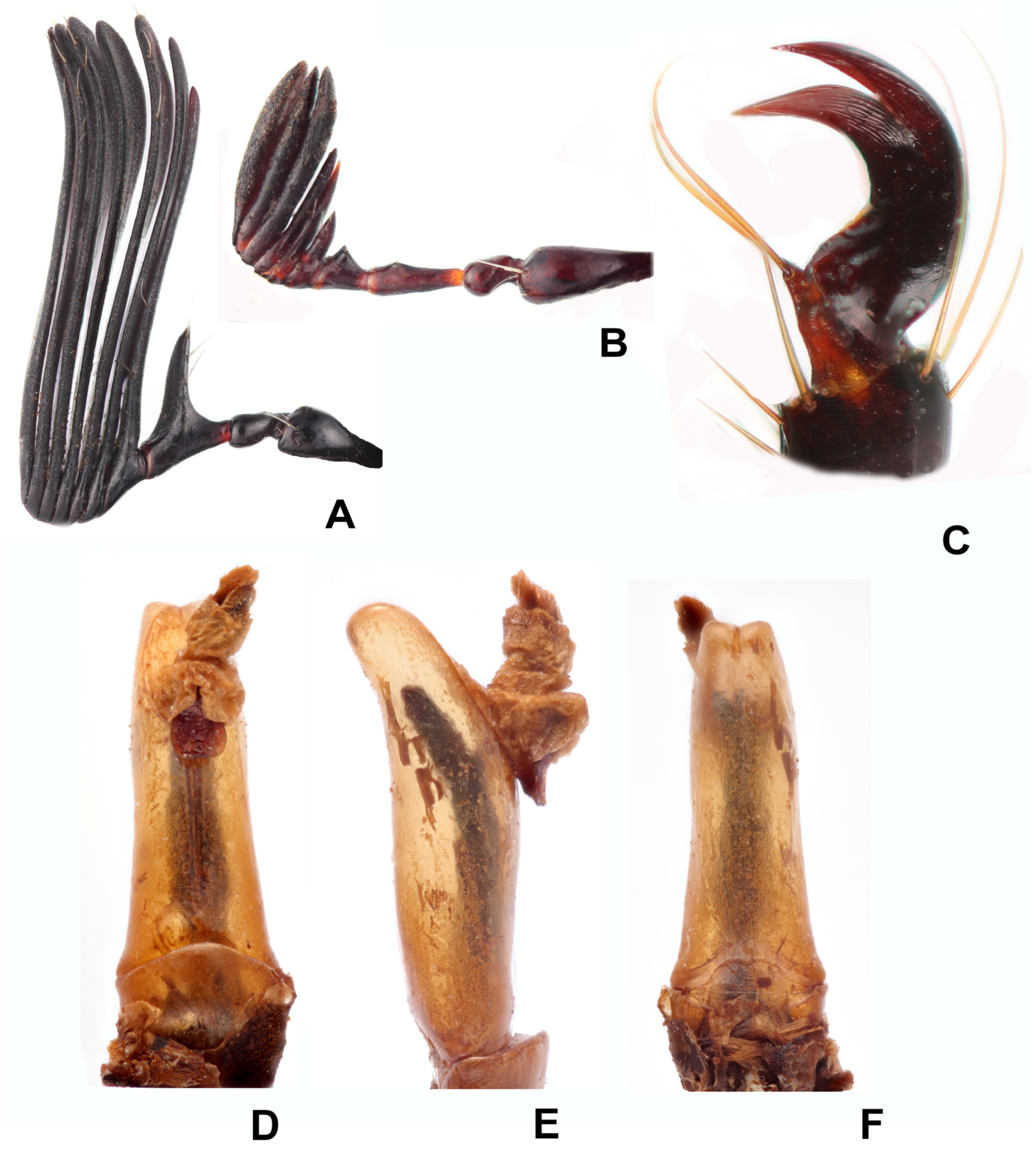
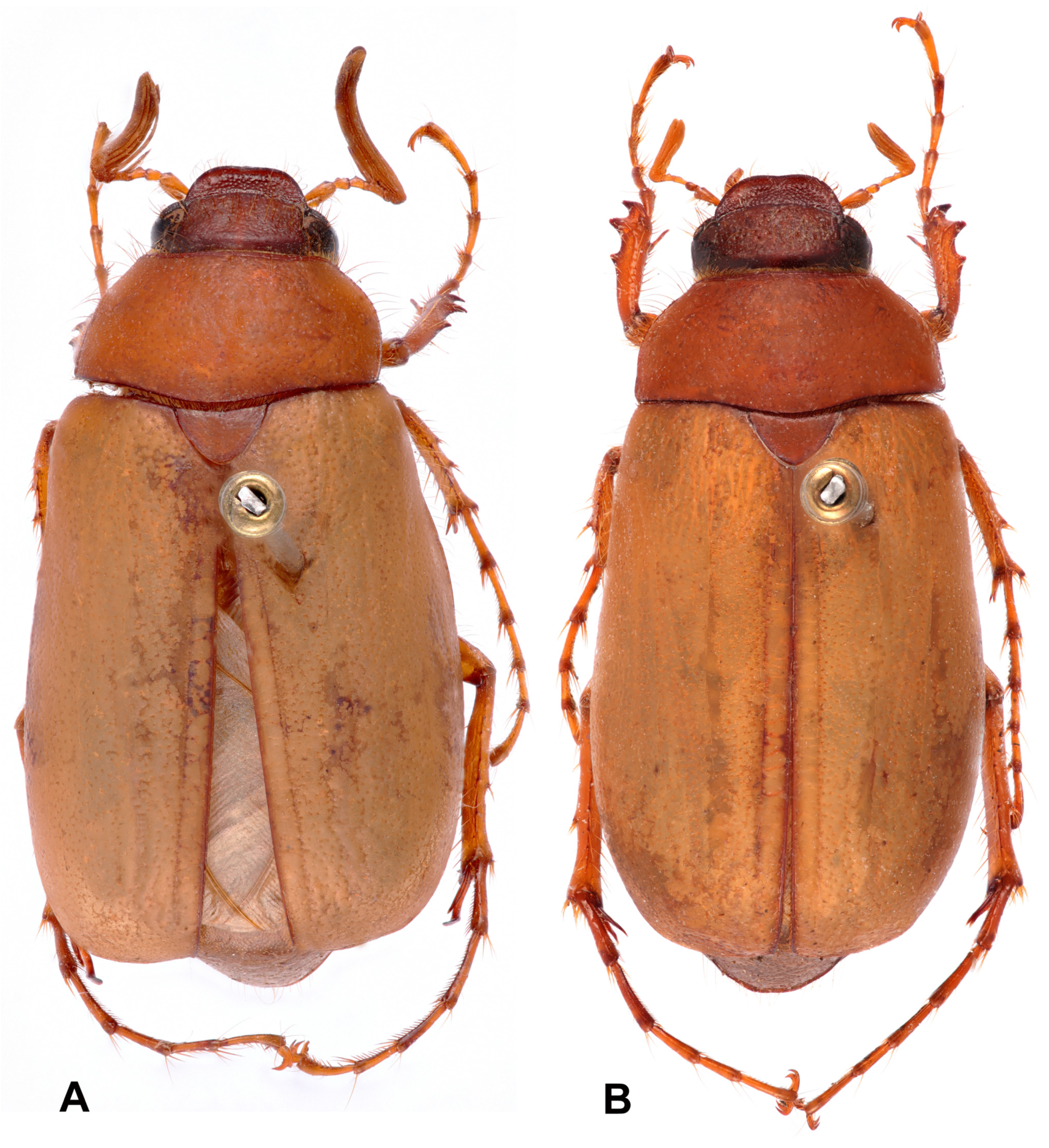
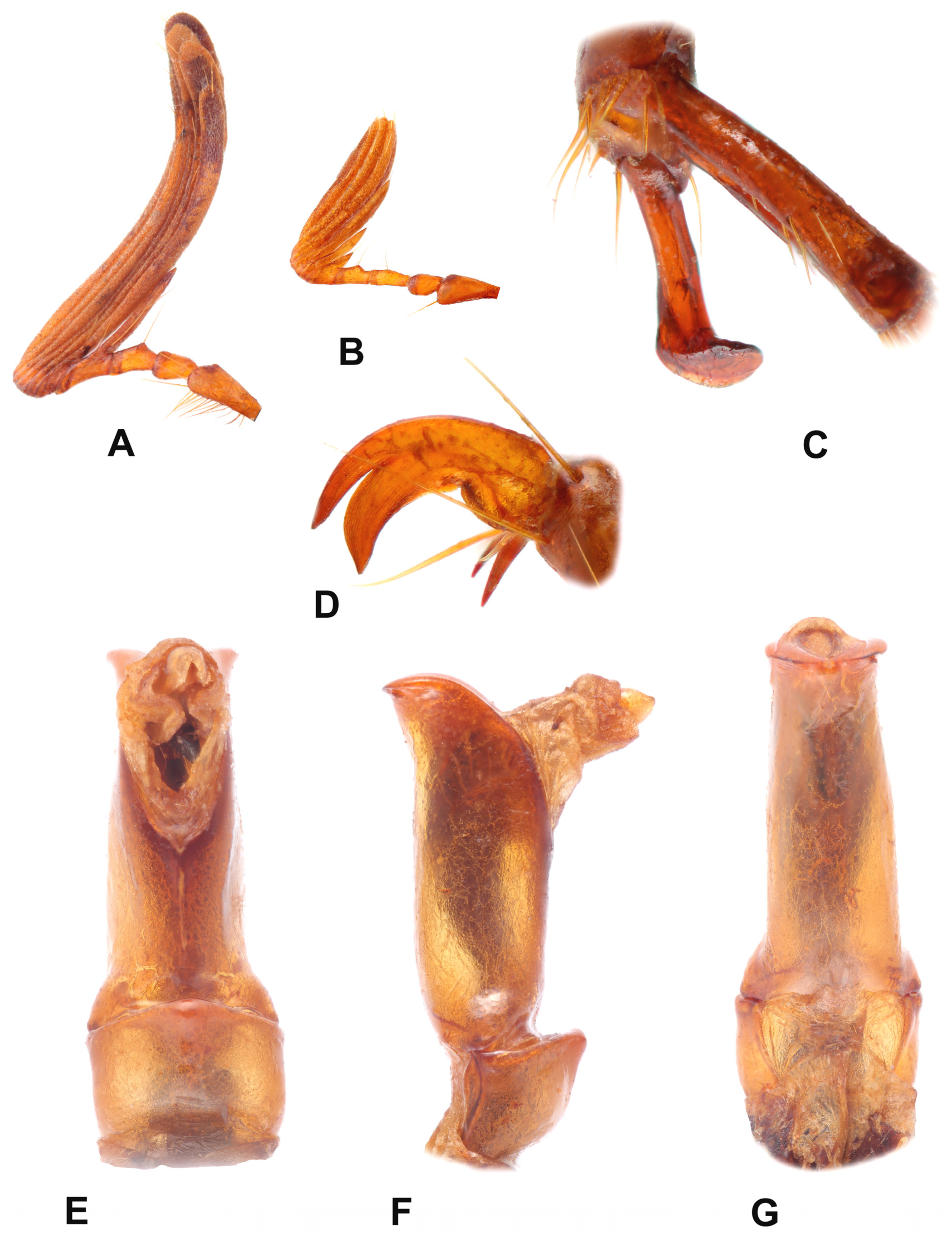
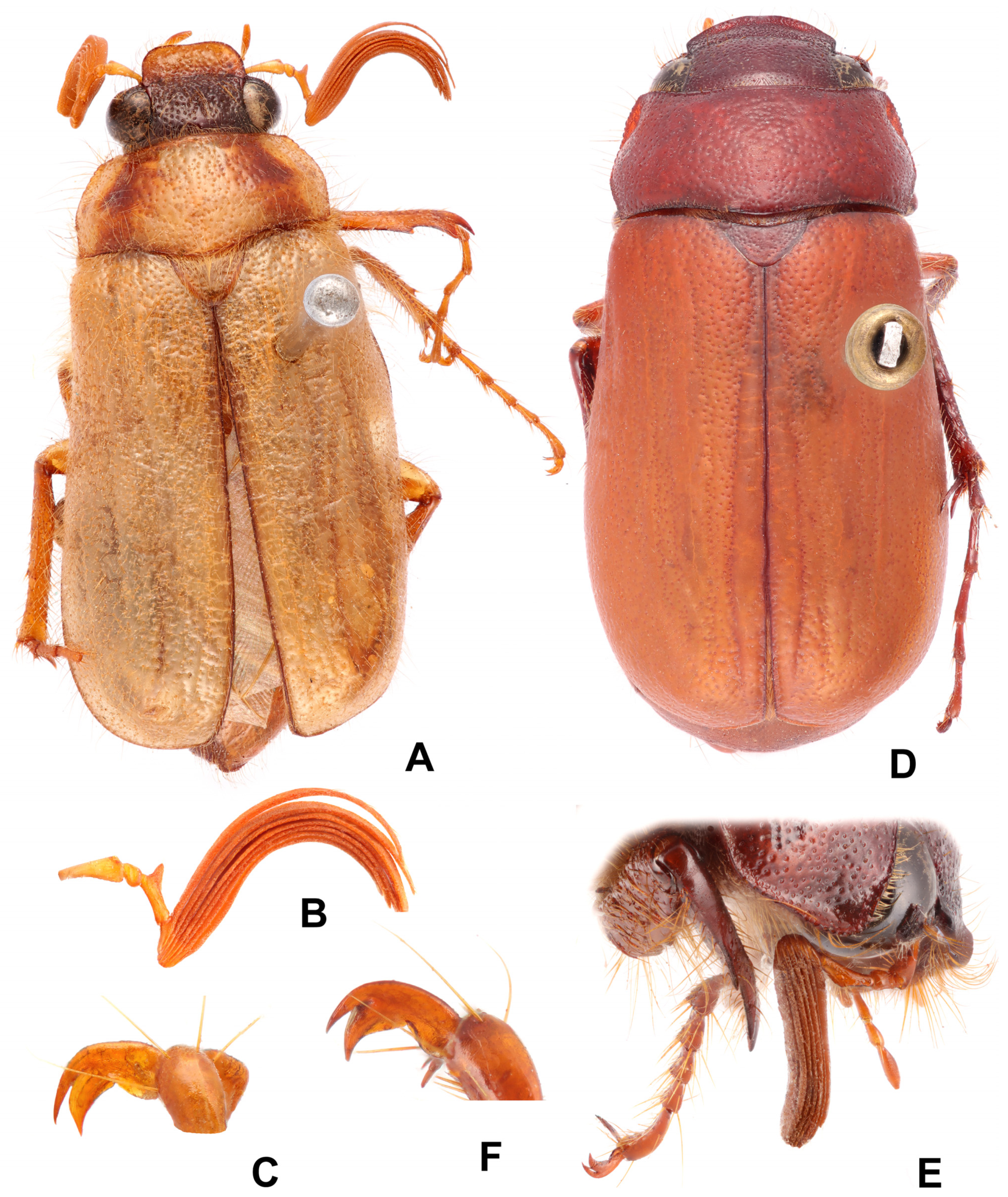

3.2. Type Material of Heptophyllini Found in IZAS and Used for Comparison (See Table 1)
3.3. Checklist of Genera and Species Currently Classified in Heptophyllini—Distribution Is Derived from the Primary Descriptions and Bezděk [4], Unless Otherwise Stated
4. Discussion
Author Contributions
Funding
Data Availability Statement
Acknowledgments
Conflicts of Interest
References
- Medvedev, S.I. Plastinchatousye (Scarabaeidae), Podsem. Melolonthinae, ch. 1 (Chrushchi). Fauna SSSR, Zhestkokrylye. Tom 10, Vyp. 1; Izdatelstvo Akademii Nauk SSSR: Moskva, Leningrad, 1951; pp. 1–512. [Google Scholar]
- Kalinina, O.I. Systematic position of the genus Hilyotrogus Fairm. and description of the larva of H. bicoloreus (Heyd.) (Coleoptera, Scarabaeidae). Entomol. Obozr. 1983, 62, 732–735. [Google Scholar]
- Motschulsky, V. Insectes du Japon. Études Entomol. 1858, 6, 25–41. [Google Scholar]
- Bezděk, A. Tribe Heptophyllini. In Catalogue of Palaearctic Coleoptera, Volume 3. Scarabaeoidea—Scirtoidea—Dascilloidea—Buprestoidea—Byrrhoidea. Revised and Updated Edition; Löbl, I., Löbl, D., Eds.; Brill: Leiden, Boston, 2016; pp. 215–216. [Google Scholar]
- Zhang, Y.-W. Coleoptera: Scarabaeoidea. In The Series of the Comprehensive Scientific Expedition to the Quinghai-Xizang Plateau. Insects of Xizang. Volume 1; Science Press: Beijing, China, 1981; pp. 339–354. [Google Scholar]
- Zhang, Y.-W. Coleoptera: Melolonthidae. In Insects of Baishanzu Mountain, Eastern China; Wu, H., Ed.; China Forestry Publishing House: Beijing, China, 1995; pp. 242–244. [Google Scholar]
- Zhang, Y.-W.; Li, Y. 1997: Coleoptera: Glaphyridae, Dynastidae and Melolonthidae. In Insects of the Three Gorge Reservoir Area of Yangtze River. Part 1; Yang, X.-K., Ed.; Chongqing Publishing House: Chongqing, China, 1997; pp. 776–779. [Google Scholar]
- Fairmaire, L. Coléoptères de lʼintérieur de la Chine (Suite: 7e partie). Ann. Soc. Ent. Belg. 1891, 35, clxxxvii–ccix. [Google Scholar]
- Arrow, G.J. Schwedisch-chinesische wissenschaftliche Expedition nach den nordwestlichen Provinzen Chinas, unter Leitung von Dr. Sven Hedin und Prof. Sü Ping-Chang. Insekten gesammelt vom schwedischen Arzt der Expedition Dr. David Hummel 1927–1930. Coleoptera, Melolonthinae. Ark. Zool. 1934, 27A, 7–10. [Google Scholar]
- Kusui, Y. Notes on some Scarabaeoidea from Shimokoshiki Island, Kyushu. Ent. Rev. Japan 1971, 23, 116–118. [Google Scholar]
- Nomura, S. Zoogeographical study on the Scarabaeoidea of the Izu Islands, with descriptions of some new subspecies. Ent. Rev. Japan 1969, 21, 71–94. [Google Scholar]
- Miyatake, M. A new species of the genus Heptophylla from Shikoku, Japan (Coleoptera: Melolonthidae). Trans. Shikoku Ent. Soc. 1963, 8, 23–25. [Google Scholar]
- Fujioka, M. A list of Japanese Lamellicornia. Kogane 2001, 1 (Suppl. S1), 1–293. [Google Scholar]
- Motschulsky, V. Insectes du Japon. Études Entomol. 1861, 9, 4–39. [Google Scholar]
- Lewis, G. On the lamellicorn Coleoptera of Japan, and notices of others. Ann. Mag. Nat. Hist. 1895, 6, 374–408. [Google Scholar] [CrossRef]
- Fairmaire, L. Description de Coléoptères de l’interieur de la Chine (Suite, 6e partie). Ann. Soc. Ent. Belg. 1891, 35, vi–xxi. [Google Scholar]
- Niijima, Y.; Kinoshita, E. Die Untersuchungen über japanische Melolonthiden II. (Melolonthiden Japans und ihre Verbreitung). Res. Bull. College Exp. Forest, College Agric., Hokkaido Imp. Univ. 1923, 2, 1–253. [Google Scholar]
- Nomura, S. Notes on some Scarabaeid-beetles from Loochoos and Formosa. Ent. Rev. Japan 1970, 22, 61–72. [Google Scholar]
- Fairmaire, L. Descriptions de coléoptères de l’intérieur de la Chine. Ann. Soc. Ent. Fr. 1886, 6, 303–356. [Google Scholar]
- Brenske, E. Ueber einige neue Gattungen und Arten der Melolonthiden. Entomol. Nachr. 1892, 1892, 151–159. [Google Scholar]
- Arrow, G.J. Systematic notes on melolonthine beetles belonging to Holotrichia and related genera. Ann. Mag. Nat. Hist. 1944, 11, 631–648. [Google Scholar] [CrossRef]
- Moser, J. Beitrag zur Kenntnis der Melolonthiden (Col.). Deutsche Ent. Zeit. 1913, 1913, 271–297. [Google Scholar]
- Brenske, E. Neue Arten der Coleopteren-Gattung Holotrichia (Lachnosterna). Berl. Entomol. Zeitschr. 1892, 37, 159–192. [Google Scholar] [CrossRef]
- Heyden, L.F.J.D. Verzeichniss der von Herrn Otto Herz auf der chinesischen Halbinsel Korea gesammelten Coleopteren. Horae Soc. Ent. Ros. 1887, 21, 243–273. [Google Scholar]
- Bezborodov, V.G. Platinchatousye zhuki (Coleoptera, Scarabaeoidea) Manchzhurii (Kitay): Fauna, ekologiya i zoogeografiya. Lamellicorn beetles (Coleoptera, Scarabaeoidea) of Manchuria (China): Fauna, ecology and zoogeography. Zool. Zhurnal 2018, 97, 639–663. [Google Scholar]
- Kim, J.-I. Arthropoda: Insecta: Coleoptera: Scarabaeoidea Laparosticti. Ins. Fauna Korea 2012, 12, 1–209. [Google Scholar]
- Arrow, G.J. Entomological results from the Swedish expedition 1934 to Burma and British India. Coleoptera; Melolonthidae. Ark. Zool. 1946, 38A, 1–33. [Google Scholar]
- Frey, G. Neue Ruteliden und Melolonthiden aus Indien und Indochina (Col.). Ent. Arb. Mus. G. Frey 1971, 22, 109–133. [Google Scholar]
- Frey, G. Ergebnisse der Bhutan-Expedition 1972 des Naturhistorischen Museums in Basel. Coleoptera: Fam. Scarabaeidae. Subf. Melolonthinae. Entomol. Basil. 1975, 1, 233–241. [Google Scholar]
- Li, J.-K. The Coleoptera Fauna of Northeast China; Jilin Education Publication House: Jilin, China, 1992; 205p, (In Chinese, English Abstract). [Google Scholar]
- Fairmaire, L. Coléoptères du Haut Tonkin. Ann. Soc. Ent. Belg. 1893, 37, 303–357. [Google Scholar]
- Bezděk, A. Tribe Heptophyllini. In Catalogue of Palaearctic Coleoptera. Volume 3. Scarabaeoidea–Scirtoidea—Dascilloidea—Buprestoidea—Byrrhoidea; Löbl, I., Smetana, A., Eds.; Apollo Books: Stenstrup, Denmark, 2006; pp. 183–184. [Google Scholar]
- Niijima, Y.; Kinoshita, E. Die Untersuchungen über japanische Melolonthiden III. (Erster Nachtrag der Melolonthiden Japans und ihre Verbreitung). Res. Bull. College Exp. For. College Agric. Hokkaido Imp. Univ. 1927, 4, 1–95. [Google Scholar]
- Keith, D. Un nouvel Hilyotrogus du Myanmar (Col. Scarabaeoidea Melolonthidae). Lambillionea 2004, 104, 727–728. [Google Scholar]
- Kollar, V.; Redtenbacher, L. Aufzählung und Beschreibung der von Carl Freiherrn v. Hügel auf seiner Reise durch Kaschmir und das Himaleayagebirge gesammelten Insecten. In Kaschmir und das Reich der Siek. Vierter Band. Zweite Abtheilung; von Hügel, K., Ed.; Hallberger’sche Verlagshandlung: Stuttgart, Germany, 1844; pp. 393–564. [Google Scholar]
- Moser, J. Beitrag zur Kenntnis der Melolonthiden (Col.). Stett. Ent. Zeit. 1921, 82, 48–73. [Google Scholar]
- Sharp, D. Preliminary diagnoses of new coleopterous Insects belonging to the fmilies Dytiscidae, Staphylinidae, and Scarabaeidae obtained by the late Dr. F. Stoliczka during the 2nd mission to Yarkand under Sir Douglas Forsythe. J. Asiat. Soc. Bengal 1878, 47, 169–174. [Google Scholar]
- Keith, D.; Zubair, A. New records for the fauna of Pakistan (Col. Scarabaeoidea). Symbioses (NS) 2013, 31, 45–46. [Google Scholar]
- Bates, H.W. Coleoptera collected by Mr. Pratt on the Upper Yang-tsze, and on the borders of Tibet. Second notice. Journey of 1890. Entomologist 1891, 24 (Suppl.), 69–80. [Google Scholar]
- Brenske, E. Neue Coleopteren-Gattungen und -Arten aus Madagaskar, Afrika und Asien, zur Familie der Melolonthiden gehörend. Berliner Entomol. Zeitschr. 1897, 1896, 339–363. [Google Scholar] [CrossRef]
- Moser, J. Beitrag zur Kenntnis der Melolonthiden (Col.). Deutsche Ent. Zeit. 1915, 1915, 113–151. [Google Scholar]
- Moser, J. Verzeichnis der von H. Fruhstorfer in Tonkin gesammelten Melolonthiden (Col.). Ann. Soc. Ent. Belg. 1908, 52, 325–343. [Google Scholar]
- Keith, D. Une nouvelle espèce de Melolonthidae du Vietnam (Coleoptera Scarabaeoidea). L’Entomologiste 2012, 68, 333–336. [Google Scholar]
- Matsumoto, T. Taxonomic notes on some melolonthine species (Coleoptera, Scarabaeidae, Melolonthinae) from Japan. Kogane 2007, 8, 31–35. [Google Scholar]
- Keith, D. Description de nouvelles espèces et d’un nouveau genre de Melolonthidae asiatiques (Coleoptera, Scarabaeoidea). Nouv. Rev. Ent. (NS) 2007, 23, 291–299. [Google Scholar]
- Wang, F.-L. Notes on Melolonthinae (Coleoptera: Scarabaeidae) from China: A new species of the genus Miridiba and new records. Zoosyst. Ross. 2024, 33, 168–175. [Google Scholar] [CrossRef]
- Matsumoto, T.; Keith, D. Notes on the rhizotrogine genus Laotrichia Keith (Scarabaeidae, Melolonthinae) from India and Indochina. Kogane 2008, 9, 21–22. [Google Scholar]
- Kobayashi, H. Four new scarabaeid beetles (Coleoptera, Scarabaeidae) from Taiwan. Elytra 1990, 18, 73–81. [Google Scholar]
- Li, C.-L.; Yang, P.-S. On the genus Taiwanotrichia from Taiwan (Coleoptera: Melolonthidae). Chin. J. Entomol. 1991, 11, 318–323. [Google Scholar]
- Keith, D.; Li, J.-K. Lamellicornes Pleurosticti du mont Wuzhishan (île d’Hainan, République populaire de Chine) avec la première citation du genre Taiwanotrichia Kobayashi, 1990 hors de Taiwan (Coleoptera Scarabaeoidea). L’Entomologiste 2009, 65, 163–166. [Google Scholar]
- Keith, D. Présence du genre Taiwanotrichia Kobayashi, 1990 en Chine continentale (Coleoptera Melolonthidae). L’Entomologiste 2009, 65, 233–234. [Google Scholar]
- Deyrolle, H.; Fairmaire, L. Coléoptères recueillis par M. l’abbé David dans la Chine centrale. Ann. Soc. Ent. Fr. 1878, 8, 87–140. [Google Scholar]
- Ahrens, D.; Scott, M.; Vogler, A.P. The phylogeny of monkey beetles based on mitochondrial and ribozomal RNA genes (Coleoptera: Scarabaeidae: Hopliini). Mol. Phyl. Evol. 2011, 60, 408–415. [Google Scholar] [CrossRef]
- Eberle, J.; Sabatinelli, G.; Cillo, D.; Bazzato, E.; Šípek, P.; Sehnal, R.; Bezděk, A.; Král, D.; Ahrens, D. A molecular phylogeny of chafers revisits the polyphyly of Tanyproctini (Scarabaeidae, Melolonthinae). Zool. Scr. 2019, 48, 349–358. [Google Scholar] [CrossRef]
| Characters | Heptophylla gongshana n. sp. | Heptophylla calcarata | Heptophylla laticollis | Hilyotrogus flavescens |
|---|---|---|---|---|
| Color | Black, two apical abdominal segments chestnut brown, shiny (Figure 1A,B) | Pale, yellow elytra, head, pronotum, and scutellum pale brownish, matt (Figure 3A,B) | Brown, matt (Figure 5D) | Yellow, head brown, pronotum with two brown longitudinal spots, shiny (Figure 5A) |
| Shape of body | Elongate, convex, distinctly expanded posteriad (Figure 1A,B) | Elongate, convex, moderately expanded posteriad (Figure 3A,B) | Elongate, convex, parallel-sided (Figure 5D) | Elongate, flattened, parallel-sided (Figure 5A) |
| Setation of elytra | Absent (Figure 1A,B) | Absent (Figure 3A,B) | Absent (Figure 5D) | Dense, short, erect setae throughout (Figure 5A) |
| Clypeus | Transversal, slightly emarginate in middle, anterior angles broadly rounded, densely coarsely punctate (Figure 1A, B) | Transversal, slightly emarginate in middle, sides regularly rounded, densely coarsely punctate (Figure 3A,B) | Transversal, emarginate in middle, sides regularly rounded, densely coarsely punctate (Figure 5E) | Transversal, emarginate in middle, anterior angles broadly rounded, sparsely coarsely punctate (Figure 5A) |
| Male antennal club | Almost straight in basal two-thirds, apical third moderately outcurved, octomerous, basal mere distinctly shortened (Figure 2A) | Strongly curved outwardly, heptamerous, basal mere distinctly shortened (Figure 4A) | Moderately curved outwardly, heptamerous, basal mere only slightly shortened (Figure 5E) | Strongly curved outwardly, heptamerous, basal mere not shortened (Figure 5B) |
| Female antennal club | Straight, hexamerous, meres gradually increasing in length toward apex (Figure 2B) | Straight, hexamerous, meres gradually increasing in length toward apex (Figure 4B) | Female, unknown | Female, unknown |
| Pronotum | Transversal, anterior angles prominent, acute-angled (Figure 1A,B) | Transversal, anterior angles weak, acute-angled (Figure 3A,B) | Transversal, anterior angles prominent, rectangular (Figure 5E) | Transversal, anterior angles obtuse-angled (Figure 5A) |
| Male calcars of metatibia | Both shaped as usual | Lower calcar modified, broadened, and hooked apically (Figure 4C) | Both shaped as usual | Both shaped as usual |
Disclaimer/Publisher’s Note: The statements, opinions and data contained in all publications are solely those of the individual author(s) and contributor(s) and not of MDPI and/or the editor(s). MDPI and/or the editor(s) disclaim responsibility for any injury to people or property resulting from any ideas, methods, instructions or products referred to in the content. |
© 2025 by the authors. Licensee MDPI, Basel, Switzerland. This article is an open access article distributed under the terms and conditions of the Creative Commons Attribution (CC BY) license (https://creativecommons.org/licenses/by/4.0/).
Share and Cite
Bezděk, A.; Král, D.; Luo, Y.-P.; Lu, Y.-Y. Heptophylla gongshana Bezděk & Král, n. sp. from China (Yunnan) and a Checklist of the Tribe Heptophyllini (Scarabaeidae: Melolonthinae). Taxonomy 2025, 5, 52. https://doi.org/10.3390/taxonomy5040052
Bezděk A, Král D, Luo Y-P, Lu Y-Y. Heptophylla gongshana Bezděk & Král, n. sp. from China (Yunnan) and a Checklist of the Tribe Heptophyllini (Scarabaeidae: Melolonthinae). Taxonomy. 2025; 5(4):52. https://doi.org/10.3390/taxonomy5040052
Chicago/Turabian StyleBezděk, Aleš, David Král, Yi-Ping Luo, and Yuan-Yuan Lu. 2025. "Heptophylla gongshana Bezděk & Král, n. sp. from China (Yunnan) and a Checklist of the Tribe Heptophyllini (Scarabaeidae: Melolonthinae)" Taxonomy 5, no. 4: 52. https://doi.org/10.3390/taxonomy5040052
APA StyleBezděk, A., Král, D., Luo, Y.-P., & Lu, Y.-Y. (2025). Heptophylla gongshana Bezděk & Král, n. sp. from China (Yunnan) and a Checklist of the Tribe Heptophyllini (Scarabaeidae: Melolonthinae). Taxonomy, 5(4), 52. https://doi.org/10.3390/taxonomy5040052






